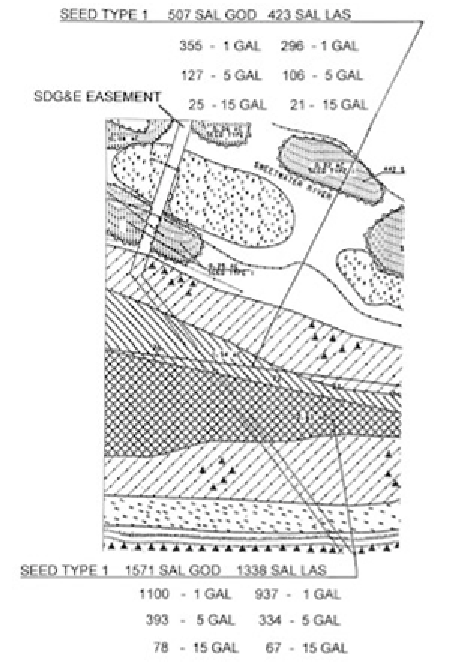Environmental Engineering Reference
In-Depth Information
taining the species, size of the plant contain-
er, and quantity to be planted—to indicate
the area in which the species are to be plant-
ed. Although this technique may appear to
result in random plantings, it actually is a
very structured technique that results in ef-
ficient use of time for both the designer and
the installing party.
A companion to the planting plan is the
plant and planting specifications. This table
contains the list of each and every species
to be planted on the project. Both botanical
and common names are used. Specific re-
quirements for each species, including how
each is to be planted and how each is to be
associated with other species and sizes, are
spelled out on the plant list specifications.
When combined with the planting plan,
this table (shown in appendix 7) ensures that
the detailed intent of the designer is carried
out in the field.
Irrigation Plan
In the arid areas of the world, almost every
restoration project requires some form of
supplemental water during the early stages
of plant establishment. Conveying supple-
mental water to a restoration project is ad-
dressed in the irrigation plan. The irrigation
plan identifies the source of water, states
whether it is potable or nonpotable, identi-
fies how it will be transported from its source to the planting areas, shows the schematic or specific
layout of the water delivery system, and specifies the watering regime that is to be followed during
the plant establishment phase.
Irrigation plans are routinely designed and developed by landscape architects or irrigation de-
signers. These professionals possess the required skills to develop a design that effectively and
efficiently conveys water to plants in their early growth stage. Some project designers install pip-
ing and sprinklers or drip emitters, while others believe hand watering for a period of months
following installation is more resource efficient though labor intensive. Volunteer participation is
critical to make hand watering cost-effective. Irrigation systems come in all shapes and sizes and
FIGURE 9-6.
Planting polygons showing different
densities of plantings. Less rigorous than shown in
figure 9-5, this was a field trial on the effect of two
planting densities on growth rate and structure.
The triangles indicate large container (thirty-six-
inch box) sycamore plantings.

Search WWH ::

Custom Search